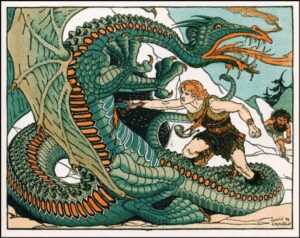Sigurd and Brynhild’s Romantic Portrayal in “Saga of the Volsungs” and William Morris’ “The Story of Sigurd the Volsung”

The style of writing is important in differentiating the elements of romance between Sigurd and Brynhild. When Sigurd meets Brynhild in the 13th-century saga, the details are much less flowery and romantic—“Sigurd thanked her for her words and gave her a gold ring. They swore their oaths anew. He went away to his men and was with them for a time, prospering greatly” (Saga 75). In Morris’ poem, the interaction between Sigurd and Brynhild reads in a more romantic light—“Then he set the ring on her finger and once, if ne’er again,/They kissed and clung together, and their hearts were full and fain” (Morris 130). The disparity in presenting Sigurd and Brynhild (two major figures) and their elements of romance in two separate lights ultimately affects the level of sympathy and attraction to them in the eyes of the reader.
William Morris’s “Sigurd the Volsung” (1876) is an epic poem retelling a collection of stories found in the 13th-century Saga of the Volsungs. While many components of the original text can be found in his work, there are some elements that have been evidently omitted and altered. In his work, Morris highlights the scene in which Sigurd meets Brynhild in grave detail—“ Then they turned and were knit together; and oft and o’er again/They craved, and kissed rejoicing, and their hearts were full and fain” (Morris 124).

The style of writing is important in differentiating the elements of romance between Sigurd and Brynhild. When Sigurd meets Brynhild in the 13th-century saga, the details are much less flowery and romantic—“Sigurd thanked her for her words and gave her a gold ring. They swore their oaths anew. He went away to his men and was with them for a time, prospering greatly” (Saga 75). In Morris’ poem, the interaction between Sigurd and Brynhild reads in a more romantic light—“Then he set the ring on her finger and once, if ne’er again,/They kissed and clung together, and their hearts were full and fain” (Morris 130). The disparity in presenting Sigurd and Brynhild (two major figures) and their elements of romance in two separate lights ultimately affects the level of sympathy and attraction to them in the eyes of the reader.
Language Discrepancy in The Saga and Morris’ Text

The dialogue that Morris utilizes throughout his piece is especially decorative; he fixates on describing the landscape of his scenes and incorporating additional dialogue into his interactions. In Morris’ retelling, he utilizes this language in describing Regin and Sigurd’s journey—“There standers Sigurd the Volsung, and leant on his sword, And beside him now is Greyfall and looks on his golden lord, And the world is awake and living; and whither now shall they wend, Who have come to the Glittering Heath, and wrought that deed to its end?” (113). This style of writing is immersed in natural dialect, considering the actions of the characters in accordance with “worldly” vernacular. In the original Saga, the language used is less charming and more formal—“Now Sigurd and Regin rode up onto the heath and onto the track along which Fafnir was accustomed to crawl where he went to drink” (63).






